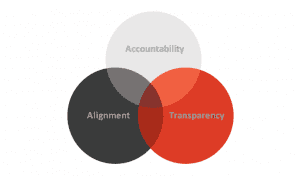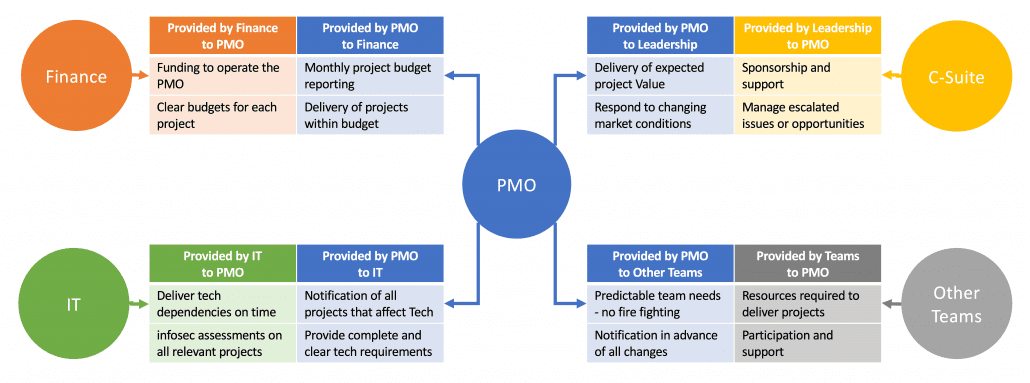Executive Summary
A project’s purpose is to deliver value to its stakeholders. And a PMO should strive to deliver value to the organization. The value provided by a PMO office can take different forms depending on the organization’s needs, and it will evolve and change as the organization grows and changes. Kim helps you look at those needs and provides insight for consideration before launching your Project Management Office.
- To PMO Or Not To PMO?
- The Wrong Way To Think About PMO
- The New Reality Of Execution
- The Right Way To Think About PMO
- PMO Value Categories
- Think In Terms Of The Value Transaction
- When a PMO Is Not the Right Way to Go?
- What If We Go “Agile” – Why Would We Need A PMO?
Do I Need to Establish A PMO (Project Management Office)?
To PMO Or Not To PMO?
Of the many questions our team gets around portfolio management, project management tools, and PMOs, probably the most important one of all is, “Do I need a PMO?”
It is so important because if you don’t have a good answer at the ready, then your portfolio, potential PMO, and future projects are all at risk.
At Kolme Group, my partners and I started as project managers and worked our way into building, managing, assessing, and fixing Project Management Offices. We work with PMO offices across many industries daily to help them run more efficiently and provide more value to their organizations.
So, when we hear the question, “Do I need a PMO?” We have a ready answer.
The Wrong Way To Think About PMO
The “old school” way to think about PMOs is that they are simply a team of project managers that enforce process and governance to make sure projects are done “right.”
This perception comes from project managers’ natural tendency toward organization, structure, and processes. This notion often expresses itself in PMOs, focusing more on adhering to the project management process than delivering value.
These organizations’ project management office turns into “Project Management Obstruction” rather than organizational enablers.
The New Reality Of Execution
Not only is it more important to focus on value than process, but the concept of a standard delivery process across an organization is becoming obsolete.
At least 71% of organizations, and maybe as many as 97%, have implemented an agile approach. This method champions team-level self-organization and, as the name implies, a propensity for flexibility.
Agile often means devising unique ways of working for each team. While there is ample evidence that self-organized agile teams are more productive at the team level, this can lead to chaos when trying to execute initiatives that span multiple teams, each working in their own way.
Cross-team collaboration is the new reality of project execution. Each team may have its own or no methodology, and the PMO office needs to coordinate with these teams to deliver enterprise-wide initiatives.
So, the modern project management office’s mission is more about adopting an agile approach and orchestrating execution in a heterogeneous environment than trying to impose some artificial homogeneous process across the organization.
The Right Way To Think About PMO
A project’s purpose is to deliver value to its stakeholders. And a PMO office should strive to deliver value to the organization. It would be best if you defined the purpose of a PMO the same way we define the purpose of an individual project.
The value provided by a PMO can take different forms depending on the organization’s needs, and it will evolve and change as the organization grows and changes. To account for this, the PMO should strive to be entrepreneurial in its leadership and lead engagement efforts within the organization.
In fact, Project Management Happy Hour podcast guest Rolondo Talbott spoke with Kim Essendrup about Entrepreneurial Project Management and how a project manager or PMO is a service organization – not a box checker but an offeror of services.
A current business trend gaining acceptance is stepping back from PMOs in the IT sector. There is a growing argument against project management methodologies and the association with loss of control.
That means it’s even more critical for PMO managers/leaders to express their office’s commitment to customer service and continuous improvement and the value and importance project and program managers have within a Project Management Office.
PMO Value Categories
Regarding the specific value a PMO provides, it falls into three general categories: Accountability, Transparency, and Alignment.
Project Management Offices typically provide value across some mix of these categories. When thinking of your existing or potential PMO, it can be a valuable exercise to work with your stakeholders to “put a pin” in the diagram below where you need the most help.
Accountability
PMO offices oriented toward accountability often serve as a point of responsibility to the executive suite for execution.
Focus areas for accountability-oriented PMOs may include:
- Responsibility for executing key strategic initiatives
- Financial accountability and reporting for the portfolio
- For Professional Services organizations, engagement profitability and customer satisfaction
- Regulatory compliance
When we talk with executives that need an accountability-focused PMO, we listen for key phrases like:
- I need someone I can trust / count-on to get our initiative done.
- How do I make sure I get the value I expected from my CapEx budget?
- How do we enforce regulatory compliance?
Transparency
Project Management Offices oriented toward Transparency focus on communication and information flow for projects and initiatives.
The goal is most often to help minimize the surprises that come from project risks and issues and to enable the organization to be more proactive in its management of risk and change.
Focus areas of transparency typically include:
- Risk and issue reporting and change management
- Resource management and planning
- Common reporting across the portfolio to identify projects that are at risk or in trouble
When we talk with executives in organizations that need a transparency-focused PMO, we often hear key phrases like:
- I know my people are busy, but I don’t know what they are doing.
- We are tired of all the surprises and firefighting.
Alignment
Project Management Offices that focus on alignment help ensure the organization’s strategic initiatives are prioritized within the portfolio and among all the other organizational activities. However, when a PMO takes this role, it does not absolve individual teams from accountability for delivering on their team-specific initiatives.
The most transformative and valuable changes are typically those that must span different parts of an organization. So, a PMO that can manage alignment across various teams is key to success.
Focus areas for alignment-oriented PMOs typically include:
- Mapping and tracking projects to strategic organizational goals and objectives
- Project intake, prioritization, and selection
- Stage-gate controls and release management
When we talk with executives in organizations that need an alignment-focused PMO, the most frequent comments we hear are:
- We spend all this money, time, and effort on projects, but our strategic initiatives never seem to get done.
- We find ourselves struggling to complete projects that we should have just terminated long ago.
Agile Project Management Office Transformation
We often see a particular ‘superclass’ of agile PMOs we often see that encompass all three of the above value types, the Transformation PMO. These organizations can be temporary and implemented to drive a specific and often radical organizational transformation.
Typical transformations that use this type of PMO include:
- Mergers and Acquisitions
- Agile transformations
- Creating a new line of business
Think In Terms Of The Value Transaction
It can be helpful to map out the value a Project Management Office can provide using a value transaction or spider diagram when considering what a PMO can provide to your organization. This tool is excellent for identifying not just the value the office provides to different parts of the organization but the level of commitment the PMO needs in return to deliver that value.
This diagram can be a great collaborative brainstorming tool to use with your PMO stakeholders. It’s also a helpful communication tool to use with your executive team.
The example below is very high-level – you will likely have more than the four teams and many more items in your value transaction tables.
When a PMO Is Not the Right Way to Go?
In simple terms, if you cannot define the value, a PMO would give to your organization, then don’t create one.
This doesn’t mean that an office cannot give you value, but if your team cannot identify how it would do that, it won’t succeed in the face of any resistance.
Another consideration regarding if a Project Management Office is the right way to go occurs when the value you do identify isn’t strong enough to get vested interest and sponsorship from your leadership team.
If they’re not buying what you’re selling, your PMO won’t survive for long.
What If We Go “Agile” – Why Would We Need A PMO?
94% of highly agile organizations report having a PMO or similar project governance team.
Project Management Offices are easy targets to catch the blame for project delivery issues. That blame then often extends to the whole discipline of Project Management, which can make organizations think, “I’ll just go Agile, and everything will be better.”
The reality is that setting up a dedicated team to drive project performance and delivery (i.e., a PMO) is a LOT easier than completely transforming an entire organization to an agile framework. And if you cannot successfully create and operate a PMO, you will likely fare worse when restructuring the entire organization.
Remember that organizational agility isn’t just about doing “Agile.” And if you are going to start an agile journey, organizing a Transformation PMO in an agile environment to drive that change can be much more cost-effective than bringing in a busload of “Big 3” consultants to do it for you.
How Do We Start?
If you think a PMO is for you, our recommendation is to start by having conversations within your leadership team about the potential value you might get from a PMO.
Map out your value transactions using a visual aid such as the spider diagram above – DOWNLOAD YOUR FREE WORKSHEET TEMPLATE.
Once you have organizational alignment on the value transactions for your proposed PMO, the next step is to start planning what the PMO should look at from an org structure, reporting, and measurement perspective.
If, however, you find that you want help with this process or support in assessing the value a PMO can give to your organization, Please Contact Us, and we’ll reach out to you shortly.
Contact Us



